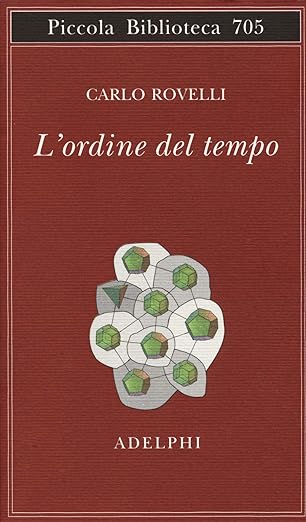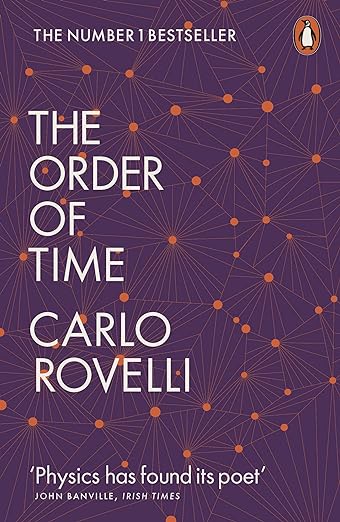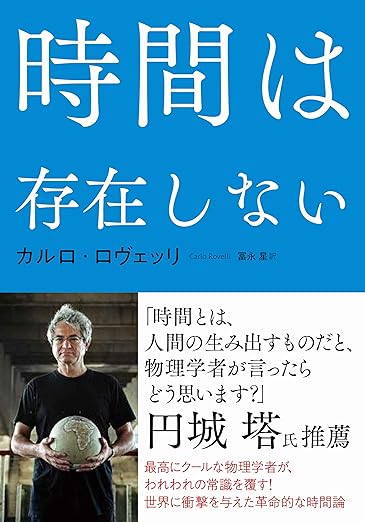


時間は存在しない (Time doesn’t exist)
by Carlo Rovelli
書評「めぐりあう書物たち」 (Book review ”Book come across”)
by 尾関章 (Akira Ozeki)
Looking at the roses, I think that early summer has arrived again. Time passes quickly as you get older. Sometimes the end of time flickers in my head as I realize that life is finite. Time is a real concern. This spring, this column read philosopher John Ellis McTaggart’s theory of time.
However, philosophy discussions only cover half the time. There is a group of people in academia who think of time from a completely different perspective. Natural scientists, especially physicists.
The natural world is made up of objects. Objects are positioned using coordinates on the spatial and temporal axes, and their movement can be described by speed, which is the change in position in space divided by time, and acceleration, which is the change in speed divided by time. We have become accustomed to seeing things that way. In modern times, the limits of Newtonian mechanics have become apparent, and complicated topics such as the theory of relativity and quantum mechanics have emerged, but the general framework of space and time appears to be intact.
As I wrote in the previous article, the time picture for liberal arts students is not straightforward, but the time picture for science majors has a good outlook. “Where is Time Born?” (written by Junichiro Hashimoto, published by Shueisha Shinsho, 2006), which was previously featured in “Book Reading by Chance”, was able to see through this rupture in literature and science.
Mr. Hashimoto pointed out this. “The theory of time expounded by modern philosophers almost completely ignores the nature of time revealed by modern physics (mainly relativity and quantum theory)” “On the other hand, the theory of time expounded by scientists is based on the framework of science.” It never comes out. It never tries to enter human time.” I feel the same way. It’s strange that even scientists can be busy or relaxed. Recently, however, people in the field of physics have begun to step into “human time.” It’s not just Mr. Hashimoto.
“Time does not exist” (written by Carlo Rovelli, translated by Sei Tominaga, published by NHK Publishing, 2019). I learned about this book in the newspaper when it was first published (Asahi Shimbun November 16, 2019, morning edition reading page, “Selling books” column). The reviewer is Takumi Fukuo, a critic. “This book is engraved with an intellect that goes beyond the easy division between liberal arts and science majors, or rather, the appeal of the humanities that can only be brought out by science majors,” he concluded. I thought the same thing when I read it. It’s no wonder that the book’s belt reads “Revolutionary Theory of Time.”
The author is a physicist born in Italy in 1956. After receiving his PhD from the Graduate School of the University of Padua, he continued his theoretical research at universities in Italy, the United States, and France. He is trying to construct a theory that combines the theory of relativity and quantum mechanics, and is one of the advocates of the “loop theory of quantum gravity.” Meanwhile, he has also written a series of physics books for the general public. This book was published in Italy in 2017. According to the author’s introduction, it has been published in over 30 countries and has become a “global bestseller.”
There are two main points in this book. The first is that physics can be done without time. The other thing is that we still feel like we have time. The latter concerns human nature. Because of the second reason, we can say that we are stepping into “human time.”
Many science fans already know that time is not absolute. This is because in the 20th century, Albert Einstein established the theory of relativity, which refuted the absolute time theory of Isaac Newton’s physics. This book also emphasizes this.
For example, at the beginning of Chapter 1, “Time changes when you change places,” it is written that “Time flows faster in the mountains and slower in the lowlands.” This is an effect of general relativity. He explains that “objects slow down time around them,” and that “the degree of deceleration is greater in flatlands than in mountains because flatlands are closer to the Earth’s center of mass. ” (Translation notes are in brackets, and bold text follows the original text.) I was perplexed by the way this story started, and then I understood it. This person is clever!
General science books that deal with Einstein’s theory of relativity usually begin with special relativity. Special relativity is a theory that deals with inertial coordinate systems, so it can be considered with an easy-to-understand image of a train and a station platform. In fact, Einstein himself first completed his special theory of relativity and then moved on to general relativity. However, the author suddenly presented general relativity to the reader. My guess is that this is because he wanted to impress that time is related to “objects.”
There is a brilliant argument in the explanation of general relativity. This is how the gravity works between the sun and the earth. “Rather than being directly attracted to each other, I think they each act on things in between.” This is the so-called proximity effect. If that’s the case, then “the sun and the earth should be causing changes in the time and space around them, just as an object submerged in water displaces the water around it.” If space-time is a transmitter of gravity, then it is a concrete block. It cannot be a rigid body like .
In the story so far, time exists. However, it is influenced by objects. To this extent, the author emphasizes objects rather than time. However, if you read it carefully, you will see that the object is not seen as absolute either. In fact, it’s the opposite. He sees objects as illusions.
This story appears in Chapter 6, “This world is made of events, not things.” He fully develops a worldview that values things more than things. He uses the example of a stone, a representative object, to make this statement. It is “a process in which it is possible to maintain its shape and balance for a very short period of time before it collapses and returns to sand.” Both classical and modern physics talk about “the way events occur,” rather than “the state of things,” and they say that “things” are nothing more than events that do not change for a while.
Based on this way of thinking, the world is a “collection of events.” Moreover, they are interconnected and form a “network of events.” Physicists have long searched for the “identity of fundamental entities” through particle research, but recently they have discovered that it is easier to understand the world by understanding the “relationships between events.” A worldview that values things over things can be rephrased as a worldview that values “relationships” over “substances.”
The author also talks about humans using the theory of “networks of events.” Human beings themselves are events that involve “complex processes in which food, information, light, words, etc. enter and exit,” but they also involve “social relationships,” “chemical reactions,” and “transactions between people of the same kind.” It becomes a “knot” in the network of “emotions” and is connected to other events. What makes this book interesting is how “food,” “light,” and “chemical reactions” are juxtaposed with “words,” “emotions,” and “social relationships.”
What cannot be overlooked is that the author views the essence of “events” as “changes.” “Events” may continue like “things,” but they only last for “a while.” Not forever. Therefore, it is better to view the world of events as “constantly changing.”
If the world is undergoing “change,” time seems to be essential. However, the author says that time is not necessary. Why is this true? This question becomes clear when we move on to Chapter 8, “Dynamics as Relationships.” We have common sense that “change” is expressed as a function of the time variable “t”, but the author does not insist on this. The way one quantity changes can be expressed in any way by relating it to the way another quantity changes. The other quantity does not have to be “t”.
Humans first related changes in things to the number of days, the phases of the moon, and the height of the sun. These gave rise to calendars and clocks, and led to “choosing one variable and giving it a special name, “time.” However, the author asserts that this is unnecessary. What I want to know is, “How do things change with respect to each other?” The basic equations of quantum gravity, which is the author’s specialty, also take the form of “pointing out possible relationships between fluctuating quantities without including time variables.”
Up to this point, I think I have gotten a vague idea of the main point of this book, which is that physics doesn’t need time. However, another difficult problem remains. Why do we feel the passage of time? I will continue reading this book next time in search of the answer to this question.
From 38 to Mr.Ozeki
Dear Mr. Ozeki,
Mr. Ozeki,
I’m worried that I might write something strange, but I’ll try writing a little.
The microscopic world of quantum mechanics seems strange if we think about it from a human-centered perspective. The macro world of the universe is full of strange things if we think about it from a human-centered perspective. However, if we can take for granted that “humans are not that special” or “the earth is not the center of the universe,” we will move away from human-centered thinking and begin to see both the micro and macro worlds as strange. It disappears. That’s the message I got from Carlo Rovelli’s The Order of Time and Reality Is Not What It Seems: The Journey to Quantum Gravity. It’s probably a wrong understanding. . .
The common sense that “change is expressed as a function of the time variable t” has come into being because humans have a “human-centered temporal perspective.” Unless we think from a human-centered perspective, isn’t event more important than “t”? I don’t think that common sense in the micro world, where there is extremely little diversity, is the same as common sense in the macro world, where diversity is abundant, but human intuitive common sense doesn’t apply in either world. There is no doubt about it.
What’s confusing is that human existence is based on the microscopic world. There is no way that the common sense of the microscopic world does not apply to the human world. If we are to try to understand ourselves using the common sense of the microscopic world, wouldn’t it be better to forget human common sense for a while? If we think about common sense in the micro world and common sense in the macro world, wouldn’t we be able to understand humans better?
There is no problem even if time is continuous according to our common sense, but discontinuous according to the common sense of the microscopic world. There are as many common senses as there are people, there are as many perspectives as there are people, there are as many worlds as there are people, and there are as many times as there are people. Within the 20 centimeters behind our eyes, there is common sense, perspective, the world, and time. . .
Carlo Rovelli’s books are interesting. I think it’s more interesting than whether it’s true or not, whether it’s true or not. Not because it makes me think about various things, because it gives me stimulation, but because it’s just interesting. Carlo Rovelli is a physicist, philosopher, and historian, which is rare in this day and age where people are so obsessed with their specialties, and I really like him.
His writing covers a wide variety of topics, and you will be surprised at the breadth of his scope. So, after reading Anaximander: And the Birth of Science, which was published this year, I wondered if Carlo Rovelli wanted to be the Anaximander of the 21st century. I think he wanted to explore knowledge based on rejecting obvious “certainty.” That’s what I thought.
From Mr.Ozeki to 38
Dear Mr. 38,
“If we can take for granted that “humans are not that special” or “the earth is not the center of the universe,” we will move away from human-centered thinking and see both the micro and macro worlds as strange. It disappears》
I feel like half of Mr. 38’s understanding was based on what I wrote in the May 12, 2023 column published today.
That is, “The Earth is not the center of the universe.”
The author is saying that we humans belong to “parts” of the universe, so it is difficult to think of us as the “center.”
The tricky part is that “humans are not that special.”
The author views this “part” as a “special” thing that allows us to feel time.
If “special” means “not particularly great,” then that’s exactly right…
One more thing, thank you to Mr. 38.
Thank you for including the English title of this book, “The Order of Time,” in your comment.
The original title is Italian, but the meaning is “The Order of Time.”
It doesn’t say “time does not exist” as the Japanese title suggests.
My impression after reading it was more like “it doesn’t exist” rather than “it doesn’t exist.”
めぐりあう書物たち/尾関章
「読む」「考える」の by chance
2023年5月5日 投稿者: AKIRA OZEKI
「時間がない」と物理学者は言った
https://ozekibook.com/2023/05/05/「時間がない」と物理学者は言った/